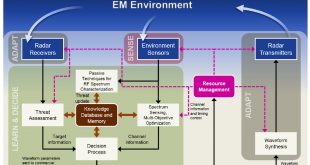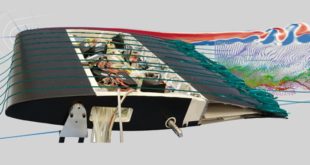Electronic warfare provide means to counter adversary’s radar and communication systems while protecting one’s own systems through Electronic Attack (EA), Electronic Protection (EP) and Electronic Support (ES). Jamming systems still rely on classified databases of known emitter signals. As radars emit energy, an onboard receiver characterises the incoming signal and and …
Read More »Cognitive and Adaptive Radar technologies can counter advanced electronic threats
RADAR offers special advantages with respect to other types of sensors including all-day, all-weather operations, long detection distance and, depending on the frequency used, penetration. Moreover, radar can often be carried by a number of platforms, spanning from classic naval and airborne to more recent space-borne, UAVs, such as drones, …
Read More »DARPA’s SAIL-ON developing military AI systems that can effectively react to an adversary’s surprise actions,
Current artificial intelligence (AI) systems excel at tasks defined by rigid rules – such as mastering the board games Go and chess with proficiency surpassing world-class human players. Current AI systems. “Imagine if the rules for chess were changed mid-game,” said Ted Senator, program manager in DARPA’s Defense Sciences Office. “How …
Read More »New Smart Materials and technologies promise shape morfing devices from morphing Wings to robot swarms
Military have large demand for smart materials and devices including smart self-repair, smart clothing such as cloaking suits, and adaptive hull structures for ships. Morphing aircraft are multi-role aircraft that change their external shape substantially to adapt to a changing mission environment during flight. This creates superior system capabilities not …
Read More »STK is AGI’s Multi-domain mission simulation software for simulating ground, sea, air, and space missions
Traditional systems engineering approaches to air systems design have been upended by two trends – increasing complexity and accelerating delivery timelines. Digital mission engineering is essential to these new challenges, enabling a system integrator to redirect work from physical systems to their logical representations. Space systems are exceptionally complex, …
Read More »NASA’s Software Assurance through Software policies, engineering practices and software standards
As computing devices become more pervasive, the software systems that control them have become increasingly more complex and sophisticated. Computers are increasingly being introduced into safety-critical systems, and, as a consequence, have been involved in accidents. The world has become reliant on software-enabled systems and components. In addition, software is now …
Read More »DARPA’s AISS program to develop tools for automatic design of secured System on Chip (SoC) for Military IoT
A system on a chip or system on chip (SoC) is an integrated circuit (also known as a “chip”) that integrates all components of a computer or other electronic system on a single circuit die. Similar to how a microcontroller integrates a microprocessor with peripheral circuits and memory, an SoC …
Read More »DARPA’s Intent-Defined Adaptive Software (IDAS) seeks technologies to make DoD Software adaptive for ever-changing military mission demands
The Department of Defense (DoD) is highly dependent on software. The increasing complexity and scale of this software is creating new attack surfaces for adversaries and reducing the DoD’s ability to react to new threats. Some examples of these complex software systems are as software used in airplanes, logistics, satellites, …
Read More »Virtual design and construction (VDC ) is being used by companies around the world to improve business performance objectives like keeping projects on time and on schedule.
Virtual Design and Construction (VDC) is a service that uses digital tools to create virtual models of buildings. These digital models are then evaluated before ground is even broken, allowing project teams to optimize the way a building is constructed. This advanced technology provides opportunities to greatly improve the construction …
Read More »China’s rapidly growing IoT market driving smart cities and industrial automation, becoming a global leader
The Fourth Industrial Revolution describes a dramatic step change in all of our lives. The confluence of high internet speeds, big data, the Internet of Things (IoT), analytics and artificial intelligence (AI) will fundamentally alter the way we live and work, intelligently connecting virtually every device, making our cities smarter …
Read More » International Defense Security & Technology Your trusted Source for News, Research and Analysis
International Defense Security & Technology Your trusted Source for News, Research and Analysis









